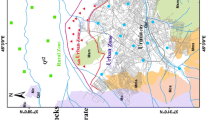Abstract
Urbanization has become one of the domain processes for city development in Indonesia. The results of the extremely high densities of fast growing population have led to negative subsurface environmental impact. Jakarta, as one of the rapidly developed and urbanized cities in Southeast Asia, has become one of the interesting urbanization city to analyze its effects. In Jakarta, the use of groundwater has greatly accelerated conforming to the rise in its population and the development of the industrial sector, which consume a relatively large amount of water. The increase of groundwater exploitation in Jakarta city has already caused a negative impact on these resources. Therefore, an assessment of groundwater trends in the urban area, including their hazard and risk management, is a necessary action. This paper describes the assessment of urban groundwater loading caused by human concentration in Jakarta city. Subsurface heat contamination under the condition of surface warming shows significant effects of urban groundwater loading during the past century in Jakarta city.








Similar content being viewed by others
References
Bredehoeft JM, Papadopulos IS (1965) Rates of vertical groundwater movement estimated from the Earth’s thermal profile. Water Resour Res 1:325–328
Carslaw HS, Jaeger JC (1959) Conduction of heat in solids, 2nd edn. Oxford University Press, New York, p 510
Goto S, Kim HC, Uchida Y, Okubo Y (2005) Reconstruction of the ground surface temperature history from the borehole temperature data in the southeastern part of the Republic of Korea. J Geophys Eng 2:312–319
Hansen J, Lebedeff S (1987) Global trends of measured surface air temperature. J Geophys Res 92:13345–13372
Huang S, Pollack HN, Shen PY (2000) Temperature trends over the past five centuries reconstructed from borehole temperatures. Nature 403:756–758
Kukkonen IT, Clauser C (1994) Simulation of heat transfer at the Kola deep-hole site: implications for advection, heat refraction and paleoclimate effects. Geophys J Int 116:409–420
Lubis RF, Sakura Y, Delinom R (2008) Groundwater recharge and discharge processes in the Jakarta groundwater basin, Indonesia. Hydrogeol J 16:927–938
Putnam SN, Chapman DS (1996) A geothermal climate change observatory: first year results from emigrant pass in northwest Utah. J Geophys Res 101:21877–21890
Sakura Y, Uchida Y, Anderson MA (1996) Effect of groundwater flow and surface warming on the subsurface thermal regime in the Nobi Plain around Nagoya, central Japan. EOS 77(17):S97
Stallman RW (1963) Computation of groundwater velocity from temperature data. US Geol Surv Water Supply Pap 1544-H:36–46
Taniguchi M, Uemura T, Sakura Y (2005) Effects of urbanization and groundwater flow on the subsurface temperature in three megacities in Japan. J Geophys Eng 2:320–325
Tarantola A (1987) Inverse problem theory: methods for data fitting and model parameter estimation. Elsevier, Amsterdam, p 613
Acknowledgments
The authors are grateful to Ir. Haris Pindratno, MM, from Jakarta Metropolitan Government, Ir. Abdurahman Assegaf M.Eng, from Trisakti University and Dr. Lambok M. Hutasoit, from Institut Teknologi Bandung, Indonesia for cooperation and useful suggestions. This research was financially supported in part by the Research Institute for Humanity and Nature (RIHN) project 2-4 “Human impacts on urban subsurface environment”.
Author information
Authors and Affiliations
Corresponding author
Rights and permissions
About this article
Cite this article
Lubis, R.F., Yamano, M., Delinom, R. et al. Assessment of urban groundwater heat contaminant in Jakarta, Indonesia. Environ Earth Sci 70, 2033–2038 (2013). https://doi.org/10.1007/s12665-013-2712-5
Received:
Accepted:
Published:
Issue Date:
DOI: https://doi.org/10.1007/s12665-013-2712-5




